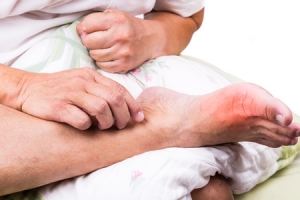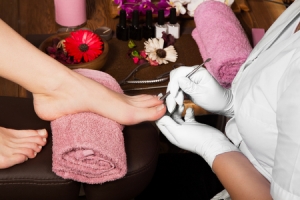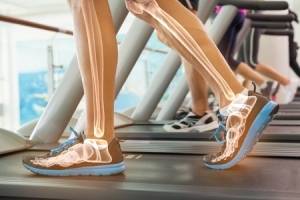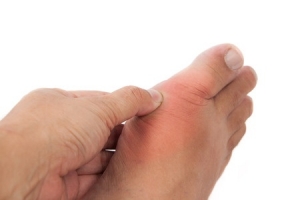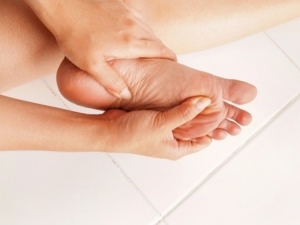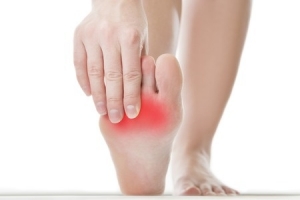Connect With Us
Blogs
Displaying items by tag: arthritis
Eat this Not That During the Holidays
A common concern during this festive time of the year is navigating all the rich, calorie-laden holiday food offerings. From Christmas cookies to eggnog to roasts, to chips, dips, and other classic favorites menus can be landmines just waiting to blow up your healthy eating plan. At Superior Foot & Ankle Care Center we know that what you eat also impacts the health of your feet. Your feet carry the weight of your entire body and when you are overweight or obese you significantly increase your risk for several foot conditions and can make existing disorders much worse. In addition, foods can trigger an inflammatory response in conditions such as arthritis and gout.
If you have a podiatric condition that is associated with inflammation check with one of our podiatrists, Dr. Victoria Foley and Dr. Constance Omelas, about the best strategies for relieving or preventing inflammation. In some cases the foot doctor may prescribe medication or other treatments. If the inflammation seems to be increasing it’s important for the podiatrist to re-evaluate your condition to check its progression and rule out other complications.
Below are some healthful swaps to keep in mind as you make your way around the party buffet:
- Eat nuts and berries instead of chips and pretzels. Not only are nuts and berries healthier choices they also help fight inflammation whereas chips and pretzels are made with refined flour that can increase inflammatory response.
- If you are prone to gout eat chicken instead of red meat.
- Choose sparkling seltzer or wine spritzers over multiple alcoholic beverages. Excess alcohol intake can trigger gout, increase inflammation and pack on the pounds.
- Pick the smoked fish over the fried oysters. Fatty fish are known to decrease inflammation while fried foods increase it and are also are much higher in calories.
- Load up on greens and salads instead of potatoes and rolls. If you plate your salads and vegetables first there will be less room for higher calorie foods.
Healthy eating is just one way to protect your feet this holiday season. If you have questions about your feet and how to best care for them contact our Long Beach office by calling: 562-420-9800.
Show Some Gratitude for Your Feet
It’s the season of Thanksgiving and here at Superior Foot & Ankle Care Center we think your feet deserve to be on the list of things that you’re thankful for! The 26 bones, 33 joints, 107 ligaments and 19 muscles in each of your feet work together in complex and amazing ways to enable you to do all the activities you enjoy. Why not show your feet some gratitude with one or more of these proactive podiatric health ideas:
Pay attention: Many times your feet are the starting place of diseases that affect your entire body such as diabetes, arthritis, circulatory and nerve problems. Get in the habit of inspecting your feet regularly and report any unusual changes to the foot doctor. Even more minor problems—ingrown toenails, warts, athlete’s foot—are more easily treated when caught in their earliest stages.
Do a shoe review: Are your shoes hurting your feet? Check to see that the shoes you wear have adequate arch and ankle support as well as cushioning for the sole. This will go a long way to preventing foot injuries and chronic conditions. Look for signs of wear and don’t continue to use shoes that are stretched out or have tears or loose stitching.
Have a spa day: pamper your feet with a relaxing foot soak. Then carefully trim toenails (straight across and not too short to avoid ingrown nails). Finish with a rich moisturizer massaged into your feet. If you prefer a salon pedicure just be sure to choose a place that follows proper sanitizing procedures for foot baths and tools to prevent fungal infections.
Watch your weight: being overweight puts excess strain and pressure on your feet and is a contributing factor in many foot problems. Maintaining a healthy weight will help reduce foot pain.
Get a checkup: When’s the last time you were in to our Long Beach office? Make an appointment by calling 562-420-9800 and let our podiatrists, Dr. Victoria Foley and Dr. Constance Omelas examine your feet. The foot doctor can alert you to any potential problems and make recommendations for ways that you can help keep your feet healthy.
Focus on Joint Health
The joints in your feet—and there are 33 of them in each foot, by the way—are what allow your bones to glide over one another enabling you to do essential activities like walking, jumping and running. As we age, the cartilage in our joints can naturally start to breakdown resulting in bone rubbing on bone and causing painful conditions such as arthritis to develop. This week we celebrate Bone and Joint Health Awareness Week and at Superior Foot & Ankle Care Center we want patients to take a proactive approach to the health of their joints because of the big impact it has on your feet and the rest of your body.
Preventing Joint Problems
Although it’s true that the conditions that affect our joints, such as gout, arthritis and osteoporosis are not completely preventable, there are steps that patients can take at any age that will help ensure joint health now and in the future.
Be Active—physical activity actually helps protect your joints in a few ways. First, exercising regularly or participating in a sport helps build and maintain muscle which supports your joints. Exercise also helps you stay flexible—with joints, the saying “use it or lose it” definitely applies. Another benefit of being active is it can help you lose or maintain a healthy weight. Being overweight puts significant strain on the joints of your feet and other lower extremities, causing them to deteriorate faster.
Eat Purposefully—your diet also plays a big role in maintaining a normal weight. Fortunately, many of the aspects of a well balanced diet also improve joint health: avoiding sugars, processed foods, fried foods and refined flours can also reduce inflammation. Some studies show that there are some foods that fight inflammation. These include: berries, cherries, certain nuts and fish and leafy greens like kale and bok choy.
Guard Against Injuries—if you take a survey of adults with arthritis, many people will attest to the fact that a site injured in youth (knee, ankle, foot) later became a site where arthritis developed. Always wear protective gear for sports and warm up and stretch before exercise.
If you do sustain an injury, contact our Long Beach office right away by calling: 562-420-9800 so our foot and ankle surgeons, Dr. Victoria Foley and Dr. Constance Omelas can examine your foot or ankle. Prompt treatment and complete rehabilitation are two ways to guard against future joint injury and disease.
What’s Behind Childhood Obesity?
At Superior Foot & Ankle Center we know the importance for your feet of maintaining a healthy weight. Obesity puts added strain on the muscles, joints and ligaments of your feet and is a risk factor for several foot disorders. September is Childhood Obesity Awareness Month and we want to help families create healthy habits now so that children will grow into healthy adults.
Contributing Factors
Thankfully, the incidence of obese and overweight children appears to have leveled off over the last decade after steadily rising for several decades before. However, we still have a long way to go. Nearly 1/3 of children ages 10-17 are overweight or obese. The lifestyle of the average child has changed dramatically from even 2 or 3 generations ago. Some reasons for the increased weight in young people include:
- Easy access to inexpensive, high calorie foods and sugary drinks
- To much time spent being sedentary and inactive
- Lack of sleep
- Increase in cost of healthy foods
- Decrease in community-oriented opportunities for physical activity
If you consider the number of “screens” most children own, the amount of pre-packaged and process food they consume and the decrease in time and opportunity to simply play outdoors or in the neighborhood, it’s easy to see how the increase in overweight children has occurred.
Ways to Help
There are many options for helping young people attain and maintain a healthy weight, including:
- Get rid of junk food and sugary sodas and snacks. If it’s too much for your family to go “cold turkey,” you can start by swapping in healthier versions of their favorite: frozen yogurt for ice cream, granola bars for cookies, baked chips instead of fried.
- Cook more meals at home. This way you control the ingredients. This is also a great opportunity to get your children involved in learning about healthy meals and helping to plan, shop and cook them.
- Get everyone a water bottle and encourage them to keep it filled. Drinking enough water everyday helps control hunger and will take the place of sweet drinks.
- Make fitness and exercise a priority for the whole family. It doesn’t have to be boring! Ice skating, rollerblading, skiing, hiking, bicycling and team sports are all good and fun choices.
By preventing obesity now when your children are young you will be helping them avoid serious medical conditions down the road which can impact their feet and entire body: diabetes, heart disease, arthritis and more. If you have additional questions about how to be proactive about your child’s foot health, our podiatrists, Dr. Victoria Foley and Dr. Constance Omelas will be happy to answer them. Contact our Long Beach office by calling: 562-420-9800.
All About Sesamoiditis
Chances are if you haven’t had sesamoiditis, you may not have any idea what it is. However, at Superior Foot & Ankle Center we often find that for patients suffering from pain in the ball of the foot, sesamoiditis is the cause.
What are Sesamoids?
Sesamoids are a unique structure in the body. They are tiny bones that are embedded in a tendon and are not connected to other bones. They are only found a few places in the body and your feet are one of them. Two sesamoids are located on the bottom of your foot at the base of the big toe. They act kind of like pulleys in the tendon, enabling it to move more easily and helping the big toe with pushing off.
Too Much Pressure
Due to their location and function in the foot sesamoids are exposed to excessive amounts of pressure and force. They can become over stressed or even injured from activities such as running and other sports, dancing, jobs that require you to be on your feet all day and having high arches or wearing high heels frequently. When the sesamoids become inflamed and irritated that is the condition of sesamoiditis.
Diagnosis and Treatment
In addition to pain in the ball of the foot, patients with sesamoiditis may also experience pain at the base of the big toe as well as swelling and bruising in that area. The big toe may be stiff and difficult to bend. Our podiatrists, Dr. Victoria Foley and Dr. Constance Omelas, will want to examine your foot, paying particular attention to the big toe. Digital x-rays (which can be done right in our Long Beach office) and other imaging studies may be needed to confirm the diagnosis.
There are a number of treatment options available for sesamoiditis, depending on the extent of the condition, including:
- Over the counter anti-inflammatory medications or steroid injections to help reduce pain, swelling and inflammation
- Bracing, taping or strapping the toe to relieve pressure and allow healing
- Wearing soft-soled, low-heeled, cushioned footwear.
- Orthotics
- Physical therapy
If you are experiencing symptoms of sesamoiditis, stop any activities that cause pain and contact us for an appointment by calling: (562) 420-9800.
Take a Good Look at Your Feet
When’s the last time that you took a good look at your feet? At Superior Foot & Ankle Care Center, we believe regularly examining your feet is a key component of good foot health. In addition, your feet are the part of your body where several systemic conditions such as diabetes, arthritis and peripheral neuropathy may first exhibit symptoms. You can examine your feet in as little as 10 minutes. Ready, set, go:
- Start by standing with your feet together and look down at them. Do you notice any difference between your two feet in size or shape? Is there any swelling in your ankles or feet?
- Now sit down so you can get a closer look at each foot. Examine the top, bottom and sides of your feet as well as between your toes. If you see any cuts or wounds make sure they are clean and appear to be healing. Check your skin. Do you notice any redness, dry flaky skin, rashes or bruises? Do you have any unusual freckles or moles that appear to have changed since the last time you looked at them? Do you see any lumps, growths, warts or new calluses?
- Examine your toenails. Nails that are discolored, thick or crumbling at the edge may indicate a fungal condition. A bluish or purplish tinge to the skin under your nails is a possible sign of a circulation issue.
- While you’re seated, take a pencil and run the erased end over the top, bottom and sides of your foot. The sensation should be equal in all parts of your foot.
- Lastly, flex your toes and feet. Do you notice any pain or stiffness in your joints?
If you spot anything that doesn’t seem quite right, contact our Long Beach office for an appointment by calling: (562-420-9800). Our podiatrists, Dr. Victoria Foley and Dr. Constance Omelas, will give your feet a complete examination and assess whether you have a foot health issue.
Making this quick foot self-check a part of your monthly health routine will go a long way to preventing foot problems as well as detecting any conditions that do develop in their very earliest stages when treatment is usually less invasive and more effective.
Excess Pressure Can Be a Pain in the Foot
Our feet are pretty forgiving. They take us where we need to go and help us stay fit by enabling us to participate in sports and exercise activities. They even accept being crammed into uncomfortable shoes now and then for the sake of fashion. However, we can push it too far. When an excessive amount of pressure is put on our feet we are susceptible to many foot disorders. One of them is metatarsalgia. This condition’s telltale sign is pain in the ball of the foot where the five long metatarsal bones end. At Superior Foot & Ankle Care Center we find that there are many ways that patients put too much pressure or uneven pressure on this part of the foot, including:
- Standing or walking for long periods of time on very hard floors or ground
- Frequently participating in weight-bearing activities such as running, dancing or basketball
- Wearing shoes that fit improperly or spending too much time in shoes with very rigid soles such as work boots or hiking shoes
- Gaining weight
Sometimes, metatarsalgia is caused by conditions that are beyond a patient’s control such as arthritis, flatfeet (overpronation), an injury or foot deformity. This condition is also more likely to occur with age as the fat pads on the bottom of our feet naturally begin to wear down.
Treating Metatarsalgia
If our podiatrists, Dr. Victoria Foley and Dr. Constance Omelas, diagnose metatarsalgia the first step will be to reduce the pain and discomfort that you are experiencing. This can usually be accomplished with rest, icing and anti-inflammatory medications. The next step will be to deal with the root cause of the condition. Depending on what the source of foot pressure is, the foot doctor may recommend changing the types of shoes you wear, losing weight, treating an existing condition or using a custom orthotic device to alleviate inflammation to the affected area.
Be good to your feet by not waiting to seek medical treatment if you are experiencing pain, discomfort or other unusual symptoms. Contact our Long Beach office for an appointment by calling: (562) 420-9800.
What You Eat Matters to Your Feet
Did you know that a significant number of foot and ankle conditions are caused or made worse by being overweight? Plantar fasciitis, arthritis, flatfeet, tendonitis and stress fractures all have excess weight as a risk factor. In addition, carrying more pounds than you should can affect your knees, hips and back which can then lead to secondary foot problems due to changes in your gait to compensate for pain in these other parts of your body. Lastly, overweight patients are more likely to develop high blood pressure, heart disease and diabetes—all of which pose serious medical threat to your feet (not to mention the rest of your body). March is National Nutrition Month and here at Superior Foot & Ankle Care Center we would like to offer these tips to improve your diet and attain or maintain a healthy weight:
- Let’s eat in—cooking meals at home puts you at a nutritional advantage. You can control the ingredients and calories in the dishes you prepare. Good food doesn’t have to be complicated. Learn some simple dishes and up the flavor quotient with herbs, spices and citrus fruits instead of fats and creamy sauces. Choose broiling or grilling over frying as your cooking method.
- Portions matter—how much you eat is almost as important as what you eat. Ask your doctor what amount of calories you should be consuming everyday to maintain a healthy weight. Check the serving sizes in the nutrition facts for the foods you eat and adjust to your daily intake if necessary. Try using a smaller plate to automatically scale back on portions.
- Variety is the spice of life—mix up your menus. Be sure to include a colorful array of different fruits and vegetables each week. By doing so, you’ll go a long way toward ensuring that you are getting all the different nutrients you need. Explore food from different cultures.
- Add some action—try to be physically active for some part of every day. This doesn’t mean you have to go to the gym or play on a team. Take the stairs, pull weeds, walk while you talk on the phone in your office—just get moving. This will help burn calories and increase fitness. Exercise can also help fight heart and other disease.
Our podiatrists, Dr. Victoria Foley and Dr. Constance Omelas, believe in a total body approach to good health. If you have questions about your weight and your feet or are experiencing pain or discomfort in your feet currently, contact our Long Beach office for an appointment.
Meeting the Needs of Seniors
At Superior Foot & Ankle Care Center, we know that our senior patients have special health care needs. Paying attention to and caring for your feet is essential to your overall health as many diseases such as diabetes, arthritis and certain nerve or circulation problems may first show symptoms in the feet. Maintaining mobility also means freedom to go where you wish and participate in the activities you love. Here are some ways that you can help protect the health of your feet if you are over 60:
- Take care of your eyes—wait, weren’t we just talking about feet? Yes, but many patients whose vision is failing have trip or fall accidents which result in sprained ankles or fractures in the foot. January is Glaucoma Awareness month. This disease currently affects more than 3 million Americans. Called “the sneak thief of sight,” vision loss from glaucoma can come on gradually and is irreversible. However, a simple eye exam can test for glaucoma (and other eye disorders) and treatment can prevent blindness. In fact glaucoma is the leading cause of preventable blindness.
- Wear shoes that fit properly without rubbing or squeezing any part of your foot. Choose shoes that have good arch and ankle support and a non-slip tread. Replace worn out shoes.
- Protect your circulation by walking frequently, avoiding sitting for long periods with your legs crossed and by not smoking.
- Keep toenails trimmed straight across and not too short to avoid ingrown nails.
- Inspect your feet daily (or if you are unable to do so ask someone to do for you). Look for bumps, bruises, swelling, changes in color, shape or skin discolorations or rashes. Report any changes to our podiatrists, Dr. Victoria Foley and Dr. Constance Omelas. Regular podiatric checkups are also an essential part of senior foot health. Most foot problems can be more easily treated and with less invasive measure if detected in their initial stages. If you have any foot concerns, contact our Long Beach office for an appointment today by calling: (562) 420-9800.
